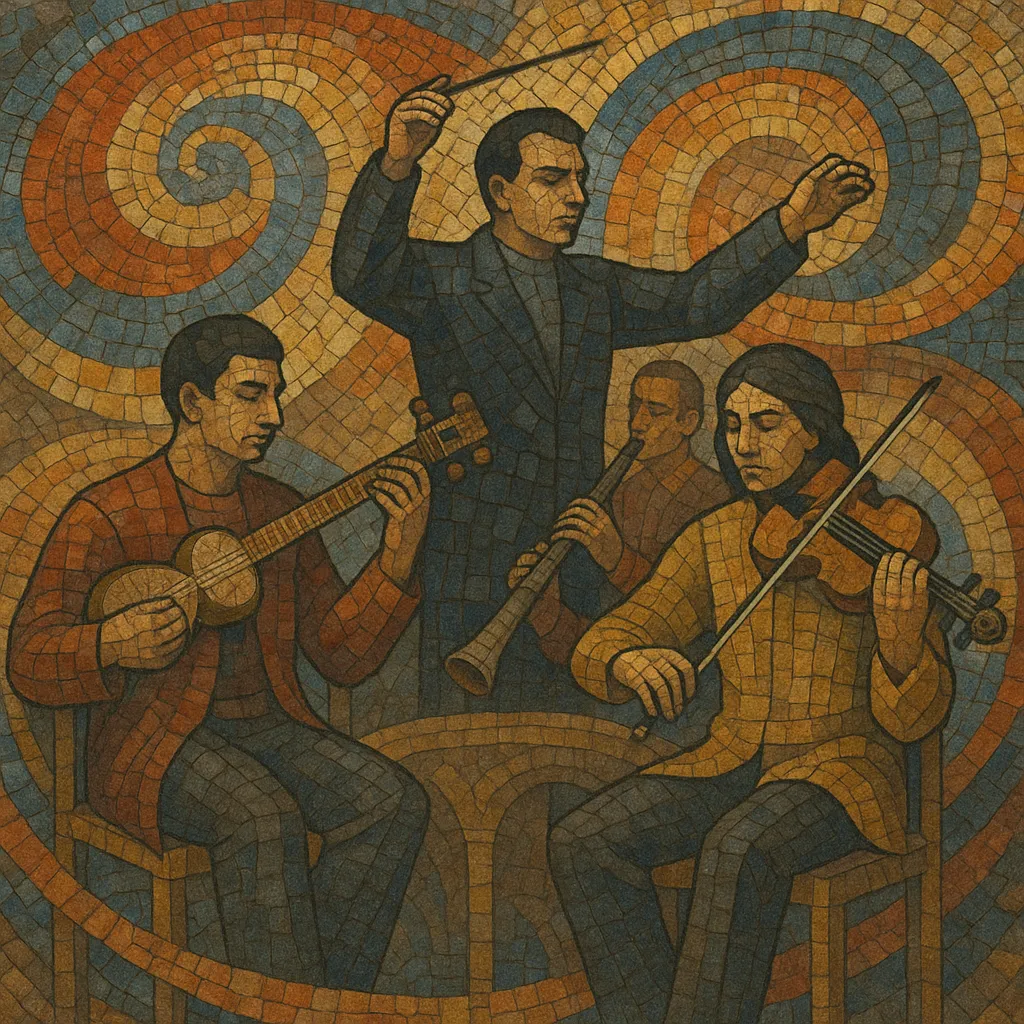
Symphonic mugham is a 20th‑century Azerbaijani concert genre that fuses the modal, improvisatory tradition of mugham with Western symphonic orchestration.
It preserves the emotive, melismatic lines and modal development (maye) of mugham while recasting them for full orchestra and, at times, soloists on traditional instruments (e.g., tar, kamancha) or Western instruments (e.g., violin, oboe).
The result is a through‑composed, large‑scale form that alternates free, rubato sections evocative of mugham improvisation with rhythmic dances (reng), using orchestral color, drones, pedal points, and non‑functional harmony to underline the mode’s characteristic intervals and cadences.
Azerbaijani composers in the early 1900s, notably Uzeyir Hajibeyov, laid the groundwork for integrating mugham with Western art music by theorizing national modal practice and applying it to operatic and symphonic forms. This intellectual and practical foundation made it possible to treat mugham not only as an oral, improvisatory art but also as material for large‑scale concert works.
The genre coalesced in the 1940s when Fikret Amirov wrote landmark Symphonic Mughams such as “Shur” and “Kürd Ovsharı,” later followed by “Gülüstan Bayatı‑Şiraz.” These works demonstrated how mugham modal development and the alternation of free and metered sections could be translated into orchestral language without losing the tradition’s expressive essence. Conductor‑composer Niyazi further advanced the idiom with symphonic treatments of mugham modes (e.g., “Rast”), helping standardize orchestration, form, and performance practice.
Subsequent Azerbaijani composers—including Vasif Adigozalov, Tofig Bakikhanov, Haji Khanmammadov, and Arif Melikov—expanded the palette: some featured traditional solo instruments against the orchestra, others emphasized modern harmonic textures while retaining modal identity. Performances by leading orchestras and tours by Azerbaijani conductors spread the genre across the Soviet Union and abroad, consolidating symphonic mugham as a signature national contribution to world concert music.
Later composers and conductors have revisited symphonic mugham with updated orchestration, extended techniques, and contemporary harmonic vocabularies. While faithful to core modal structures (e.g., Shur, Segah, Rast, Bayati‑Shiraz), modern works often explore new timbral blends, flexible microtonal inflection within tempered ensembles, and concertos for tar or kamancha with symphony orchestra. Today, symphonic mugham stands as a vital point of dialogue between oral modal tradition and global orchestral practice.
Select a specific mugham (e.g., Shur, Segah, Rast, Bayati‑Shiraz). Identify its maye (central pitch), characteristic intervals, cadential tones, and typical modulatory pathways. Plan a formal arc that mirrors traditional development: free, improvisatory introduction leading toward more rhythmic dance sections (reng), with climaxes and repose points mapped to modal goals.
Structure the piece as a sequence of contrasting sections: rubato (improvisatory) passages that emulate mugham’s vocal or instrumental taqsīm‑like unfolding, followed by metered episodes with clear usul (rhythmic cycles), often in lilting 6/8 or 3/4. Use returns to the maye as structural pillars and employ recurring motifs to unify the whole.
Use full symphonic forces (strings, winds, brass, percussion, harp) to color modal gestures. Strings can sustain drones/pedal points and execute slides, trills, and mordents that imitate mugham ornaments. Woodwinds (oboe, clarinet, flute) are ideal for lyrical, melismatic solos; brass can underline cadences or heighten climaxes. Optionally feature tar, kamancha, or balaban as soloists for authentic tone color; if absent, orchestrate their idioms for violin, viola, or clarinet.
Favor modal drones, sustained pedals, and quartal/quintal sonorities over functional tonality. Chordal writing should support, not obscure, the mode’s scalar identity. Use parallel lines, heterophony, and layered ostinati to emulate ensemble mugham textures. Where appropriate, incorporate controlled aleatory or written‑out ornamentation to suggest improvisation while remaining fully notated for orchestra.
Alternate free‑time sections with clearly pulsed dances (reng). Introduce usul‑like patterns in percussion (frame drum/daf, tef, or orchestral equivalents) and lower strings. Employ syncopations and cross‑rhythms to energize transitions into climactic zones, then relax into rubato for cadential repose.
Approximate microtonal inflections through portamento, grace‑note turns, and expressive intonation within the tempered system; where resources allow, notate quarter‑tone bends or use flexible instruments (strings, trombone) for crucial inflections. Write cadenzas for soloists to simulate improvisatory breadth before tutti responses.
Provide clear cues for tempo flexibility in rubato sections (senza misura, feathered beams, or free‑timed bars) and precise metronomic markings for dance episodes. Indicate ornamental styles explicitly and include short performance notes explaining the mode’s key tones and expressive goals to align the orchestra’s phrasing with mugham aesthetics.

